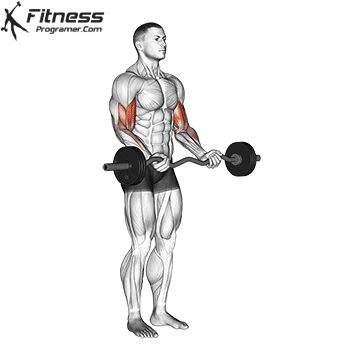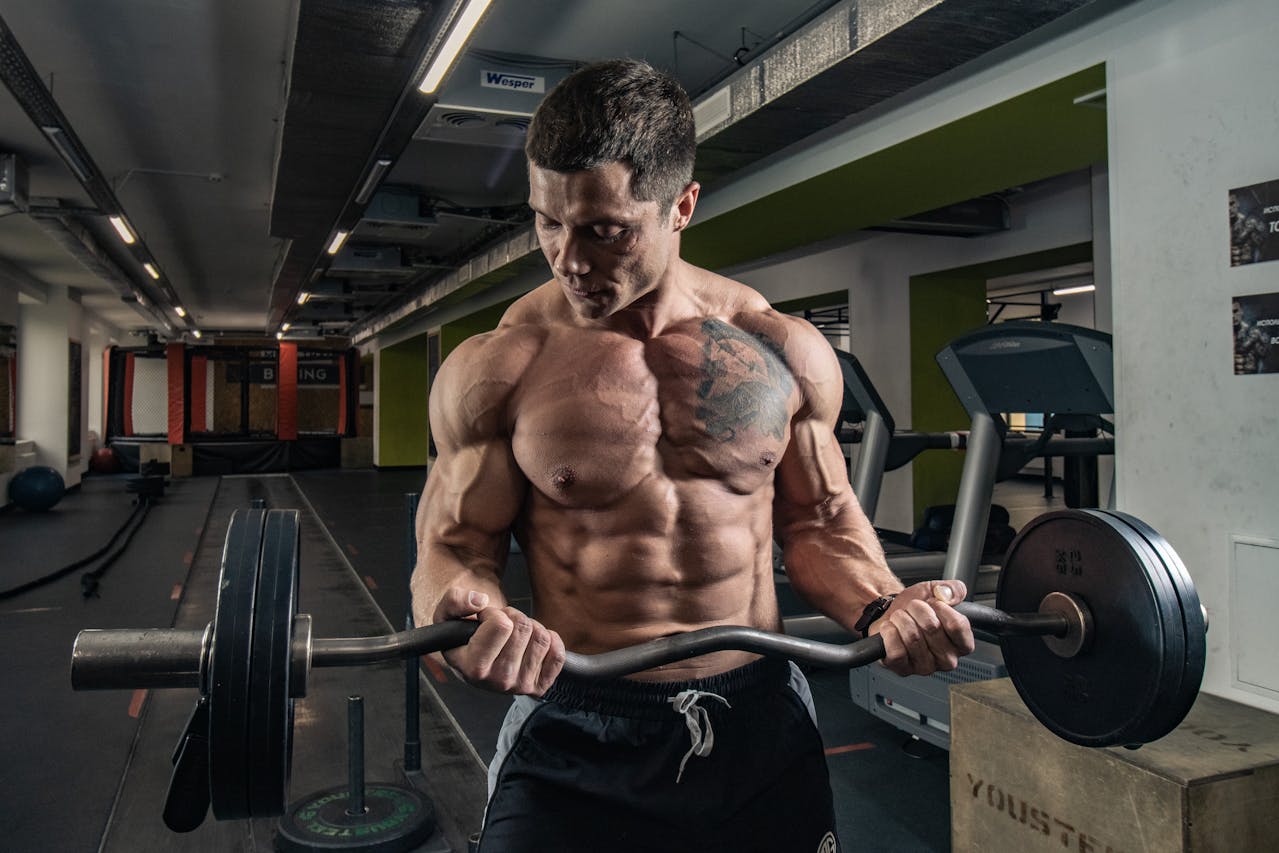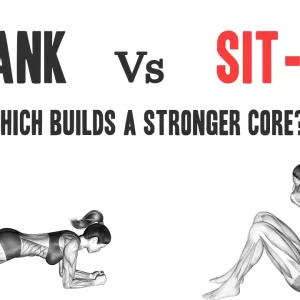Contents
- What Is the EZ Bar Curl?
- EZ Bar Curl vs. Straight Bar Curl: Key Differences
- Muscle Activation: What Does the Research Say?
- Joint Health and Comfort: A Major Advantage
- Is the EZ Bar Curl Effective for Hypertrophy?
- Programming the EZ Bar Curl in Your Training
- Common Mistakes to Avoid
- Conclusion: Is the EZ Bar Curl Worth It?
- References
The EZ curl bar, known for its angled grip design, has become a fixture in many gyms, both commercial and home. Despite its widespread use, some lifters and fitness experts still question whether the EZ bar curl is truly beneficial for building biceps.
To address this, we need to look at the unique mechanics of the EZ bar, the way it activates muscles, and how it stacks up against other biceps exercises like straight bar curls and dumbbell curls. We’ll also look at its potential joint health benefits, its role in hypertrophy programming, and whether it’s a must-have or a nice-to-have tool for arm training.
What Is the EZ Bar Curl?
The EZ bar curl is a biceps isolation exercise done with an EZ curl bar, which is a short barbell featuring angled grips. These grips let your hands take a semi-supinated or neutral-supinated position. The angles of the grips reduce wrist and forearm rotation, usually leading to less strain on the wrists and elbows compared to a straight bar.

Lifters perform the movement much like a traditional curl: the bar starts at arm’s length and is lifted through elbow flexion until the forearms are vertical or slightly above. The bar is then lowered back under control to the starting position.
EZ Bar Curl vs. Straight Bar Curl: Key Differences
| Feature | EZ Bar Curl | Straight Bar Curl |
|---|---|---|
| Grip Position | Angled / Semi-supinated | Fully supinated |
| Wrist Stress | Reduced | Increased (especially for those with mobility issues) |
| Forearm Activation | Moderate | Higher (due to rotational demands) |
| Comfort | Greater, especially for elbow/wrist discomfort | May aggravate existing joint issues |
| Load Tolerance | High (but typically less than straight bar) | High |
| Short Head Emphasis | Slightly reduced (due to less supination) | Potentially greater |
Both variations engage the biceps brachii, but the EZ bar might slightly decrease activation of the short head due to its less extreme supination.
However, the comfort and stability offered by the EZ curl bar often allow lifters to work harder, longer, and more frequently, especially when joint discomfort would limit performance with a straight bar.
Muscle Activation: What Does the Research Say?
EMG studies comparing curl variations suggest that:
- The biceps brachii remains the primary mover in all variations, including EZ bar curls.
- EZ bar curls tend to slightly reduce peak short head biceps activation compared to fully supinated grips.
- However, the brachioradialis and brachialis show increased or similar activation with the EZ grip, making it a well-rounded arm builder.
These results imply that while the EZ bar curl may not target the biceps with maximum peak activation compared to a strict supinated curl, it more comfortably involves other elbow flexors and allows for more joint-friendly loading—especially useful during volume-based hypertrophy training.
Joint Health and Comfort: A Major Advantage
One of the most cited benefits of the EZ bar is its ability to reduce strain on the wrists and elbows, which are often vulnerable during repetitive curling with straight bars. The angled grip shifts the forearm into a more neutral position, minimizing external rotation at the shoulder and torsion at the wrist. This makes it an excellent option for individuals experiencing:
- Golfer’s elbow (medial epicondylitis)
- Wrist tendon discomfort
- Limited forearm supination or shoulder mobility
For this reason alone, many coaches recommend the EZ bar curl as a long-term staple in arm training routines, even if it’s not always the most biomechanically “pure” biceps isolation movement.
Is the EZ Bar Curl Effective for Hypertrophy?
Yes. Despite a slight tradeoff in supination, the EZ bar curl remains highly effective for building both biceps size and overall arm mass due to the following reasons:
- It allows you to train heavier without compromising joint comfort.
- You can accumulate more training volume over time with less fatigue.
- You recruit supporting muscles like the brachialis and brachioradialis, contributing to upper arm thickness.
- It lends itself well to intensity techniques like drop sets, tempo curls, and mechanical advantage supersets.
When programmed alongside dumbbell curls and hammer variations, EZ bar curls contribute significantly to a well-rounded arm development program.
Programming the EZ Bar Curl in Your Training
The EZ bar curl can be used effectively in several training contexts:
- As a primary strength builder with heavier sets of 6–8 reps
- As a volume driver with moderate weight in the 10–15 rep range
- As part of supersets or circuits, alternating with shoulder or triceps work
- As a recovery-friendly alternative during deloads or when returning from elbow/wrist issues
Example Hypertrophy Superset:
- EZ Bar Curl – 3 × 10–12
- Incline Dumbbell Curl – 3 × 12–15
(Rest 60–90 seconds between supersets)
Common Mistakes to Avoid
- Swinging the bar or using momentum instead of strict elbow flexion
- Not fully extending at the bottom, reducing range of motion
- Using an excessively narrow or wide grip, which can strain the wrists
- Leaning back to lift heavier weights, placing stress on the lower back
Form is critical with the EZ bar curl. Even though it’s joint-friendly, excessive load or poor technique can still lead to suboptimal recruitment or injury.
Conclusion: Is the EZ Bar Curl Worth It?
Yes—the EZ bar curl is absolutely worth including in your training routine, particularly if you value long-term joint health, progressive overload, and training consistency. While it may not isolate the biceps as precisely as some other variations, its ability to reduce discomfort and facilitate load progression makes it an outstanding tool for hypertrophy-focused athletes.
Rather than asking whether the EZ bar curl is better or worse than other curls, the more effective strategy is to incorporate it into a balanced arm routine that includes straight bar curls, dumbbell curls, and hammer curls. This approach ensures that all heads of the biceps and surrounding elbow flexors are trained effectively, promoting maximum arm development over time.
References
- Signorile JF, et al. (2002). Electromyographic analysis of muscle activity during traditional and modified dumbbell curls. J Strength Cond Res.
- Schoenfeld BJ. (2010). The mechanisms of muscle hypertrophy and their application to resistance training. J Strength Cond Res.
- Oliveira LF, et al. (2009). EMG analysis of biceps brachii in different curl exercises. J Sports Sci Med.
- Saeterbakken AH, et al. (2020). Effects of different biceps curl variations on muscle activation and strength performance. PeerJ.
- Boeckh-Behrens WU, et al. (2003). Biomechanical analysis of forearm position in biceps curl variations. German Journal of Sports Medicine.



